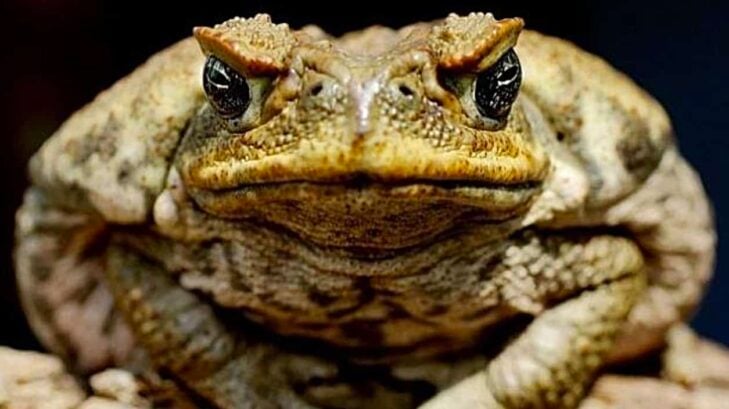With the warm weather coming it looks like the toxic cane toad, which is an invasive species is making its way north in Florida and that can a problem to your pet if you live in the area.
They’re on the march (hop). Poisonous cane toads are an invasive species and warmer weather means they’re moving north. Today at 530 on @WFTV pic.twitter.com/RKebrfOTvL
— Christopher Heath (@CHeathWFTV) February 4, 2020
All it takes is a small lick or quick sniff from these bad boys and your dog or cat can be dead within a matter of 15 minutes. The experts say that the toad hopped its way up from their native land in Central and South America to southern Florida. Now they are making their move to Central Florida and who knows where they will go from there.
https://www.facebook.com/brisbanebreakingnews/photos/bc.AbqxflV2sI0A3APkFYqoaGTyokzBIsnczCWtK4LLaIyqQUzVROgEDddbEycy06o5wMqNOXoFiY4KiegNxv1VKaZmUnZeJ1Ybf5QJZG0QR8So9KaINlX4Ac4U7SecpPoioTe3VH0mXsvCINnLoFXlBQg_/1039076582834560/?type=1&opaqueCursor=AbrMjXK_WuQgaKr007MEYSKrVegPr9REnKHc3IHTCDCAsuAZfIES7YIT-cnz_RCfeU0nloHb9RsRSrb_pbbK1dd4-R5X1x5Lfqs3Es2ISXDsj32wGq8web7KcCEa50z8Fs_KvGC1ouDPb5cf-BgDy7wD1GOPLIoRRXDMD8dI8P3Ryy9xqVJL3setcuFRTLG7LB8hnhCP16AKhsW-lplcU6MibgTpfckGc_V0uXVYXzzk_XOVO8SMaQ9FcRGnEg8rionhnJFgGDcr2W8aE8wovaSDKpXgAH-k5jeTASsQ6wi-P74yCGn_XB-AUJEpYEplB9xSb0KVqW_EydMA9EHcM4pT84FrZaHLq0gQRgSJWRJMXfvs3G9i0T5KSVNzSBKj9Phu20f0QN0lVIJkFJXoQQ6CdThON3Ynb_3791bp_bE4NYWxZOfjkbN0z-iKBVIvF4LJEQPaqnp6XShAgPOjXCASav4hGXPL5woJnSSLR71byNtu8VCcoGTGn6oKEkWEp9H8KKlEaSmyPi5byDu5QACP&theater
They were originally introduced to Florida to fight off insects that were devastating American’s sugar industry. However, instead, they have killed many of our native species like other frogs, lizards, and smaller animals.
The toad releases poison from its skin that is toxic to humans and animals, but more lethal to animals though than humans. They are the largest toads on the planet. Take a look below just to get an idea of how big these things can get.
https://www.facebook.com/reptilehunter/photos/bc.Abqq0-fvfAZWuA0MmujID5hGZfXOAMnjyX0NZjKajDq8S1jk2HAGSTatUGabjICtJMu_uGt48Ou4w_3_0RdzrVBOemTM87itp0PTFjadHHCcteqv98E_AXSyYYm8ew6ILcIITOrXQZakQAPA8V8CT8t6/540102062690546/?type=1&opaqueCursor=Abqk5oKZu86pW2uDX3EFhLNKPGhQNoDxTJLnIXaOKNAzV149_pfJuke0V2UchPJlspx6ELJkMDK0T-W6mYZ_s42qJhgIJBPyKqM3ircq9mu9ta5UMIIJHTXhcmIZBnS52g2HttmSXHsxVlVhz6utykQwsskFDYNTVWWBwDHYTJT6MfsTPBqD6PowCFNobM1Az_XsZ0gnjlc-MjeWLPA09hgoumzircwKA2H3ryGzlr1MRzGU2H_F5NAKIJ0S-4v1xm3YYYilkj6vZMLaCWCXla76rL4eqaNYIFBig7jMIU5a00nhTunr76mHdzt_PHuZM6_NN6uPVVsn7b_AUNIDj_Fm0xUotMwc6AQzQCa0FHU1IYjq41LyDyDcUSVpT4nPOPrQUeYY22Zr-vfVHJs46PsdiRO2AQKxTeWwlv5FS7aXPL_CYLN8oAHcIViYh-jMttzHPesP27eMHdwcjc83271lw38N5X7fdMTxiPJN-gpv_J2J4B0zpMfQO-xHMpVwOHGu5_EjD1bzU3Qv9qRSNm25rby5fEsELgGwPvzz5zuTRpl_6zLAthEC5srQvoZiwWI&theater
“It’s not something you’d want to get on your skin, or get in your mouth or any sort of mucus area like your eyes or nostrils, or anything like that.” Audrey Smith from the Brevard Zoo told WFTV.
Florida Fish and Wildlife Commission officers say that if you spot one you have full permission to kill it. It must be done in a humane way though. They instruct that you use gloves and put Orajel on the toad’s belly, then you put it in the freezer for 24 hours.



